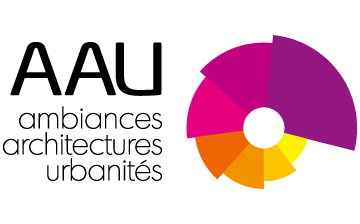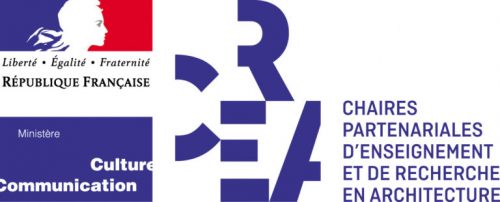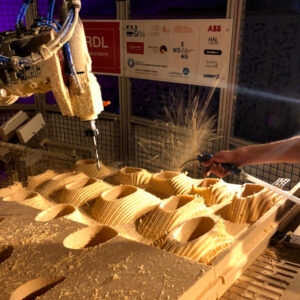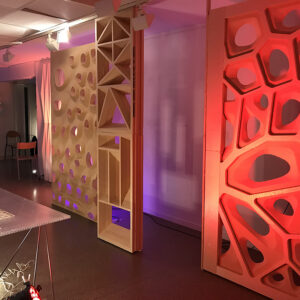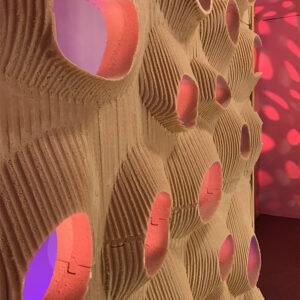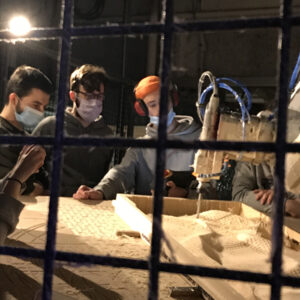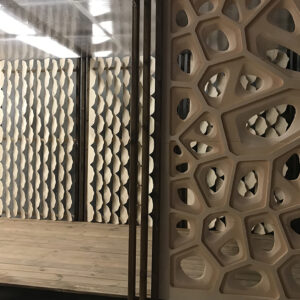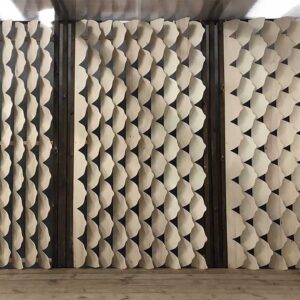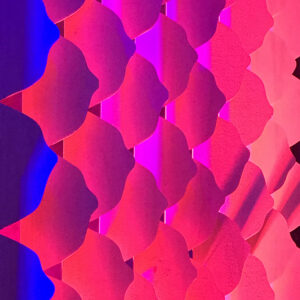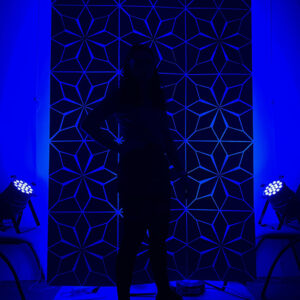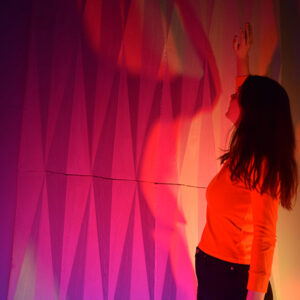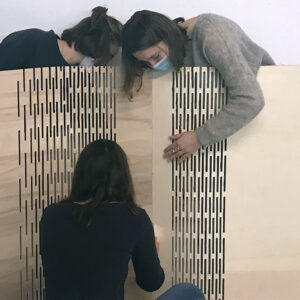Chaire Digital RDL
La chaire partenariale « Digital RDL, Research by Design Laboratory - Ecologie numérique, Design environnemental, Architecture 2.0 » labellisée par le ministère de la Culture, s’attache à la transition numérique de la discipline architecturale à travers le développement d’une démarche de recherche par le design qui permet de programmer, concevoir, fabriquer, percevoir et évaluer des architectures « non standard ».
Digital RDL Research Chair
The “Digital RDL, Research by Design Laboratory – Ecologique numérique, Design environnemental, Architecture 2.0” partnership research chair, labelled by the French Ministry of Culture, is committed to the digital transition of the architectural field through the research by design approach, which allows to program, design, build, experience and evaluate “non-standard” architectures.
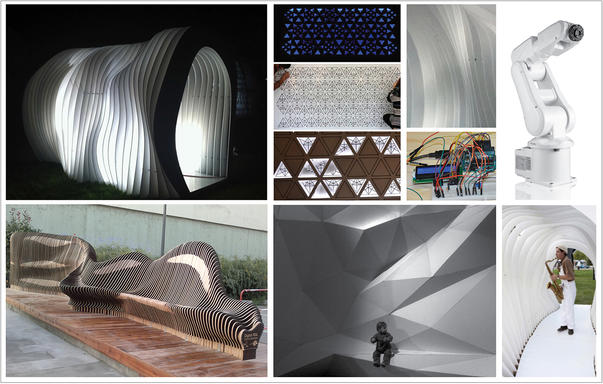
Digital RDL – non-standard architectures, situated research.<br /> Design > Production > Experience<br /> Photo credit: P. Liveneau<br />
FR
La chaire Digital RDL – Research by Design Laboratory « Ecologie numérique – Design environnemental – Architecture 2.0″ est l’une des 4 chaires labellisées par le ministère de la Culture.
- Porteur de projet : Philippe Liveneau
- Partenaires scientifiques : l’Ecole Nationale Supérieure d’Architecture de Grenoble, AAU-CRESSON, Université Grenoble Alpes, LIG (Laboratoire informatique de Grenoble), l’INRIA, le GEM (Grenoble Ecole Management), le LIPhy (Laboratoire interdisciplinaire de physique), le LNC (Laboratoire Neurosciences Cognitives), le CEMAM (Centre of Excellence of Multifunctional Architectured Materials).
- Partenaires industriels : Transdev, Procédés Chesnel.
Assumant les termes de la 3ème révolution industrielle qui caractérisent l’anthropocène actuelle, la chaire partenariale « Digital Research By Design Laboratory – Ecologie numérique, design environnemental – architecture 2.0 » mobilise un écosystème de partenaires interdisciplinaire et multisectoriel (IRT, Equipex, Idex, Laboratoires, Collectivités, partenaires privés et partenaires industriels) autour de filières de formations d’étudiants de second cycle et de troisième cycles des écoles d’ingénieurs, d’architecture et de management partenaires et réunis dans le cadre de trois recherches situés.
La singularité de la chaire est de développer une recherche par le design centrée sur la morphogenèse de milieux ambiants programmés, conçus, réalisés puis évalués et reconfigurés. Cette démarche de design environnemental va au-delà d’une pratique classique
de « living lab » en ce qu’elle est plus étendue, (de la conception à l’usage) et s’appuie sur la reconfiguration des objets de recherche en situations « réelles » qui impactent directement la société civile (mobilier connecté / espace immersif / architecture interactive).
Cette chaire construit la transition numérique de l’architecture en mobilisant une expertise acquise sur l’usage des outils numériques les plus avancées en modélisation, simulation, optimisation, production (fabrication additive, technologies soustractives, production robotisé), en mécatronique, en instrumentation de la matière mais aussi en captation, analyse, gestion et évaluation de données.
Plus largement, la chaire identifie, manipule et développe les technologies clés génériques (KETS), ressorts technologiques d’une mutation disciplinaire.
Parallèlement à l’usage des systèmes « cyber physique » qui caractérisent une matérialité numérique pervasive et ubiquitaire, la chaire mobilise en outre l’expertise des sciences sociales et des sciences cognitives pour appréhender l’expérience vécue et les transformations comportementales qui accompagnent la perception et l’usage d’une architecture non standard et la généralisation d’affordances numériques qui caractérisent nos milieux en devenir.
Digital RDL – Recherche Enseignement Equipement Espace articule :
- Un programme de recherche, SCIARC, Stratégie de Conception et d’Innovation Architecturale (Perception des formes non standard, Design d’interaction, Morphogenèse atmosphérique et Génie des procédés),
- Un programme d’enseignement de la Théorie et de la Pratique de la Conception Architecturale et Urbaine, en cycle licence et en cycle master, filière AA&CN – Architecture, Ambiances et Cultures numériques.
- Un équipement dédié : le Fab LAB / la cellule Robotique / L.E.I.C.A
- Un espace dédié, l’EIC (Espace d’Innovation Créative).
EN
The Digital RDL – Research by Design Laboratory “Ecologie numérique – Design environnemental – Architecture 2.0” research chair is one of the four labelled chairs by the Ministry of Culture.
- Project leader: Philippe Liveneau
- Scientific partners: Graduate school of architecture of Grenoble, AAU-CRESSON, Université Grenoble Alpes, LIG (Laboratoire informatique de Grenoble), INRIA, GEM (Grenoble Ecole Management), LIPhy (Laboratoire interdisciplinaire de physique), LNC (Laboratoire Neurosciences Cognitives), CEMAM (Centre of Excellence of Multifunctional Architectured Materials).
- Industrial partners: Transdev, Procédés Chesnel.
Undertaking the terms of the third industrial revolution that define the current Anthropocene, the “Digital Research by Design Laboratory – Ecologie numérique, design environnemental – architecture 2.0” partnership research chair brings together an ecosystem of cross-cutting and multisectoral partners (IRT, Equipex, Idex, Laboratories, Communities, private partners and industrial partners) around under- and postgraduate educational fields within engineering, architecture and management schools in partnership as part of three situated research works.
This specific chair aims to develop a research by design centred around the morphogenesis of programmed, designed, produced then evaluated and re-configured ambient milieus. The environmental design approach goes beyond the “living lab” traditional practice, as it is broader (from design to use), and relies on the re-configuration of the research subjects in “real” situations, directly influencing civil society (connected furniture/immersive space/interactive architecture).
This research chair develops architecture’s digital transition by mobilising an expertise acquired about the most advanced digital tools regarding modelling, simulation, optimisation, production (additional manufacturing, subtractive technologies, automated production), mechatronics, material instrumentation, as well as capture, analysis, management and data evaluation.
More broadly, the research chair identifies, manipulates and develops Key Enabling Technologies (KETs), the technological elements for disciplinary mutations.
Along with the use of cyber-physical systems that characterise a pervasive and ubiquitous digital materiality, the research chair involves the expertise from social and cognitive sciences to grasp the lived experience and behavioural transformations that support the perception and the use of a non-standard architecture and the generalisation of digital affordances defining our future milieus.
Digital RDL – Recherche Enseignement Equipement Espace (Research Education Equipment Space) articulates:
- A research programme: SCIARC, Stratégie de Conception et d’Innovation Architecturale –Design and Architectural Innovation Strategy (Perception of non-standard forms, interaction design, atmospheric morphogenesis and process engineering);
- An under- and postgraduate curriculum of Theory and Practice of Architectural and Urban Design, AA&CN course – Architecture, Ambiances et Cultures numériques (Architecture, Ambiances and digital cultures);
- Dedicated equipment: Fab LAB/robotic cells/L.E.I.C.A;
- Dedicated facilities: EIC – Espace d’Innovation Créative (Creative Innovation Space).
FR
Les thèses en cours dans le cadre de la chaire Digital RDL
Maxime Bonnefoy, architecte DE / Doctorant en Sciences pour le vivant.
Mots-clés : architecture, transdisciplinarité, biomimétisme, comportement, pattern, morphologie
Amal Abu Daya, architecte.
Mots-clés : prototype, architecture, outils numériques, conception architecturale.
EN
Ongoing theses as part of the Digital RDL research chair
Maxime Bonnefoy, Architect/PhD Student in Life Sciences.
Keywords: architecture, transdisciplinary, biomimicry, behaviour, pattern, morphology
Amal Abu Daya, Architect.
Keywords: prototype, architecture, digital tools, architectural design.
